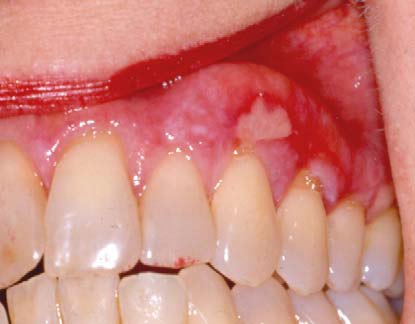Oral lichen planus (OLP) is a chronic, autoimmune-mediated inflammatory condition that affects the mucous membranes of the mouth. Characterized by bilateral, white, lace-like lesions and, in some cases, painful erosions, OLP poses both clinical and diagnostic challenges. Although its precise etiology remains unclear, it is believed to involve immune dysregulation targeting basal keratinocytes of the oral epithelium.
While generally considered a benign condition, oral lichen planus has a small but significant potential for malignant transformation, necessitating vigilant monitoring and long-term management.

Pathogenesis of Oral Lichen Planus
The underlying mechanism of OLP is thought to be a T-cell-mediated autoimmune response against basal epithelial cells. This leads to degeneration of the basal cell layer and a dense band-like lymphocytic infiltrate in the lamina propria.
Diagram: Pathogenesis of Oral Lichen Planus
Triggering factors may include systemic diseases, stress, viral infections (e.g., Hepatitis C), or hypersensitivity to dental materials and medications.
Clinical Variants of Oral Lichen Planus
OLP manifests in several forms, each with distinct clinical features. Proper identification is critical for effective treatment and prognosis.
1. Reticular Oral Lichen Planus
- Most common variant
- Interlacing white striae (Wickham’s striae) on the buccal mucosa
- Often asymptomatic
2. Erosive (Ulcerative) Lichen Planus
- Painful erythematous areas with ulceration
- May interfere with eating and oral hygiene
- Higher risk of malignant transformation
3. Atrophic Lichen Planus
- Diffuse erythema and thinning of mucosa
- Associated with burning sensation
4. Plaque-Type Lichen Planus
- Resembles leukoplakia
- Thick white patches, commonly on the dorsal tongue
5. Bullous Lichen Planus
- Formation of vesicles or bullae that rupture, leaving erosions
- Rare presentation
Common Sites Affected by Oral Lichen Planus
- Buccal mucosa (most frequent)
- Tongue
- Gingiva (desquamative gingivitis)
- Palate
- Lips
Lesions are usually bilateral and symmetrical, distinguishing OLP from other localized oral pathologies.
Etiological and Risk Factors
Though the exact cause is idiopathic, several contributing factors have been identified:
- Autoimmune dysregulation
- Genetic predisposition
- Psychological stress
- Infections, especially Hepatitis C
- Allergic reactions to dental materials (amalgam, gold)
- Medications including NSAIDs, antihypertensives, and antimalarials
Signs and Symptoms of Oral Lichen Planus
- White lace-like lines (Wickham’s striae)
- Red, swollen tissues
- Burning or stinging sensation
- Sensitivity to spicy or acidic foods
- Erosions or ulcers
- Metallic taste
- Bleeding on brushing (in gingival involvement)
The severity and symptoms vary depending on the clinical subtype.
Diagnostic Approach to Oral Lichen Planus
Clinical Examination
- Bilateral, symmetric white lesions on buccal mucosa or tongue
- Presence of Wickham’s striae
Histopathological Evaluation
- Hyperkeratosis
- Degeneration of basal layer
- Band-like lymphocytic infiltrate
Direct Immunofluorescence
- Helps differentiate OLP from lichenoid drug reactions or lupus erythematosus
Differential Diagnosis
- Leukoplakia
- Lichenoid drug reaction
- Lupus erythematosus
- Pemphigoid or pemphigus vulgaris
- Candidiasis
Potential for Malignant Transformation
Oral lichen planus is classified as a potentially malignant disorder, with transformation rates estimated between 0.4% and 3%. Erosive and atrophic types, especially in older adults, carry a higher risk.
Regular follow-ups and biopsy of suspicious lesions are imperative for early detection of dysplasia or carcinoma.
Treatment and Management of Oral Lichen Planus
There is currently no definitive cure for OLP. Treatment aims to alleviate symptoms, reduce inflammation, and monitor for malignant changes.
Topical Therapies
- Corticosteroids (e.g., clobetasol propionate, fluocinonide)
- Calcineurin inhibitors (e.g., tacrolimus, pimecrolimus)
- Retinoids
- Antiseptic mouthwashes (chlorhexidine)
Systemic Treatments
- Oral corticosteroids for severe or refractory cases
- Immunosuppressants (azathioprine, mycophenolate mofetil)
- Biologic therapies in rare, resistant cases
Adjunctive Measures
- Stress management
- Elimination of potential triggers (e.g., drug substitution)
- Treatment of secondary infections (e.g., candidiasis)
- Gentle oral hygiene practices
Prognosis and Long-Term Outlook
OLP follows a chronic relapsing course, with symptom-free intervals. Though benign in most cases, long-term monitoring is essential due to the risk of malignant transformation, especially in erosive and atrophic forms.
Regular dental visits, maintenance of good oral hygiene, and biopsies of non-healing lesions form the cornerstone of long-term care.
Frequently Asked Questions:
What causes oral lichen planus?
OLP is primarily autoimmune, with genetic and environmental factors such as infections, stress, and drug reactions contributing to its onset.
Is oral lichen planus contagious?
No, OLP is not contagious and cannot be transmitted through contact or saliva.
Can oral lichen planus become cancerous?
Yes, especially erosive and atrophic forms have a small but notable risk of malignant transformation.
What is the best treatment for oral lichen planus?
Topical corticosteroids are the first line of treatment. Severe cases may require systemic therapy or immunosuppressants.
How long does oral lichen planus last?
It is a chronic condition that may persist for years with periods of remission and relapse.
Oral lichen planus is a complex mucocutaneous disorder that demands careful clinical evaluation, precise diagnosis, and ongoing management. Through timely therapeutic intervention and routine surveillance, we can significantly reduce discomfort and mitigate the risks associated with this potentially malignant condition. Long-term patient education and multidisciplinary care play vital roles in improving quality of life and preventing complications.